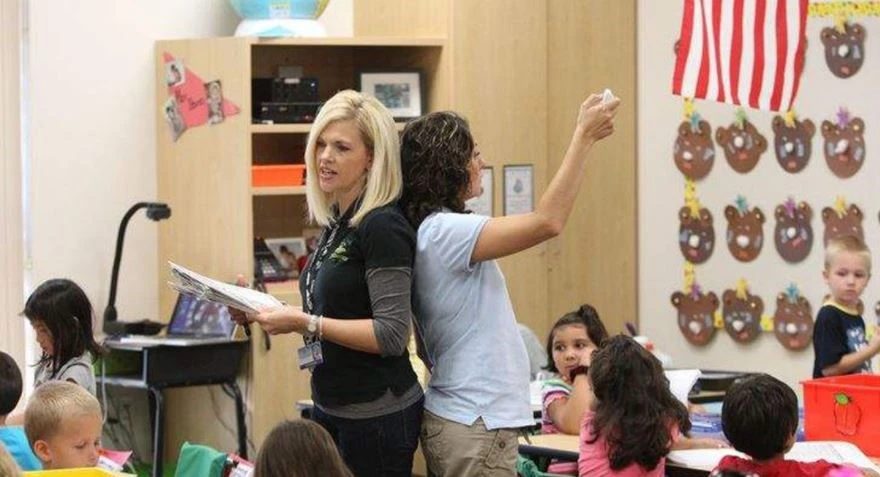
The school management system provides a comprehensive solution for educational institutions, offering a range of features tailored to meet the unique needs of schools. In the ever-changing world of education, collaboration among educators is becoming increasingly important. Team teaching is an effective method used in schools to promote teamwork and improve teaching outcomes. Strong teacher teams can help schools improve their instructional programs and boost student learning. In this blog, we will look at the notion of team teaching, the benefits of developing strong teacher teams, and the pros and cons of team teaching to help you make an informed decision about introducing this approach in your school.
What is Team Teaching?
Multiple teachers collaborate in the same classroom to give instruction. This collaborative method enables teachers to pool their knowledge, share duties, and deliver a more holistic learning experience for their pupils. The team teaching methodology varies, but popular arrangements include co-teaching, parallel teaching, and station teaching.
Co-teaching:
Two or more teachers share responsibility for instructing the same group of students. They collaborate on lesson planning and delivery.
Parallel Teaching:
Teachers divide the class into smaller groups and teach the same content in various groups.
Station Teaching:
Teachers set up various stations in the classroom, each focused on a certain aspect of the subject, and students rotate through them.
The purpose of team teaching is to leverage each teacher's talents, resulting in a better educational experience and more individualized support for students.
The Benefits of Building Strong Teacher Teams
Building effective teacher management has various advantages that benefit both instructors and kids. Here's how.
Enhanced Collaboration:
When instructors collaborate as a teacher team, they can share ideas, resources, and instructional practices. This partnership contributes to:
Create Innovative Lessons:
Using various teaching styles and strategies might result in more engaging and effective lesson ideas.
Support Each Other:
Teachers can help and advise their colleagues, creating a supportive professional environment.
Improved student outcomes:
Team teaching allows teachers to create a more dynamic and interesting learning environment. Benefits include:
Diverse Perspectives:
Students benefit from various teaching methods and perspectives, which can improve their grasp of the content.
Individualized Attention:
With many teachers in the classroom, kids receive more individualized help and feedback, which addresses their specific learning needs.
Professional Development
Working as part of a teacher team provides chances for professional development:
Peer Learning:
Observing and interacting with others allows teachers to learn new insights and abilities.
Shared Expertise:
Teachers can bring their particular abilities to the team, expanding their teaching repertoire.
Increased Support
A well-structured teacher team gives additional support in the following areas:
Classroom Management:
Having numerous teachers makes it easier to manage classroom conduct and keep students engaged.
Administrative activities:
Sharing administrative activities, such as grading and lesson planning, decreases individual workloads and stress.
Team Building for Teachers
Teachers must engage in effective team building to ensure the success of their team teaching initiatives. Here are some ideas for developing excellent teacher teams:
Clear communication
Open and honest communication is essential for developing an effective teaching team:
Regular team meetings:
To discuss lesson plans, handle concerns, and provide feedback.
Transparent Goals:
Establish clear and shared team goals to ensure that everyone is on the same page and working toward the same objectives.
Developing Trust and Respect
Building a positive working connection among team members is critical.
Respect Differences:
Recognize and value the many teaching styles and views that each team member provides.
Support Each Other:
Create a supportive environment in which team members offer assistance and constructive comments.
Collaborative Planning
Effective planning is required for successful team teaching.
Joint Lesson Planning:
Work together to create lesson plans that are consistent and coherent.
Shared Resources:
Use shared resources and materials to make preparation easier and avoid duplication of effort.
Professional Development
Ongoing professional development strengthens teacher teams.
Training Workshops:
Attend workshops and training sessions on team teaching and collaboration.
Peer observations:
Involve observing and providing comments on each other's teaching practices to enhance and refine skills.
Team Teaching Pros and Cons
While team-teaching offers many benefits, it also comes with potential challenges. Understanding both the pros and cons can help you make the most of this approach.
Pros of team teaching
While collaborative teaching has many advantages, it can also provide obstacles. Understanding both the benefits and drawbacks might help you make the most of this strategy.
Diverse Perspectives:
Team teaching offers many perspectives and instructional techniques, increasing students' learning experience.
Enhanced Student help:
With more teachers accessible, kids receive more help and specialized attention, which improves their academic performance.
Shared Workload:
Teachers can delegate responsibility for lesson planning, grading, and classroom management, lowering individual workload and stress.
Cons of Team Teaching
Potential for Conflict:
Differences in teaching styles and philosophies might cause disagreements among team members. It is critical to discuss these disputes openly and move toward resolution.
Coordination Challenges:
Effective team teaching necessitates excellent cooperation and communication. Without it, there may be inconsistencies in teaching approaches and classroom management.
uneven Practices:
If not adequately prepared, team teaching can lead to uneven teaching practices, confusing students and affecting their learning experience.
Best Practices for Successful Team Teaching
Consider these best practices to optimize the benefits of team teaching while addressing any problems.

Define clear roles and responsibilities
Make sure that each teacher's position and responsibilities are properly stated.
Avoid overlap:
Clearly define duties and responsibilities to avoid confusion and duplication of efforts.
Leverage Strengths:
To maximize teaching effectiveness, assign duties based on each teacher's strengths and knowledge.
Maintain regular communication
Regular communication is essential for a successful teaching team.
Frequent Check-Ins:
Set up regular check-ins to discuss progress, handle concerns, and alter plans as required.
Open Dialogue:
Create an environment in which team members feel comfortable discussing their thoughts and concerns.
Be flexible and adaptable
Adaptability is critical to successful team teaching.
Adjust tactics:
Be willing to change your teaching tactics and approaches based on feedback and student requirements.
Embrace Change:
Be willing to change positions or duties as needed to increase the team's effectiveness.
Encourage Ongoing Professional Development
Continue to invest in professional development:
Training and Workshops:
Attend training sessions and workshops aimed at improving team teaching and collaboration skills.
Collaborative Learning:
Use collaborative learning experiences with team members to improve teaching practices.
Conclusion
Creating strong teacher teams and implementing team teaching can significantly improve the educational experience for both students and teachers. Schools can provide diverse and effective teaching techniques, increase student results, and support teacher professional development by using the capabilities of multiple instructors. However, it is critical to be aware of the benefits and drawbacks of team teaching and to handle any issues that develop through excellent communication and preparation.
By embracing team building for teachers and using best practices, educators can foster a friendly and collaborative environment that benefits everyone involved. Explore team teaching ideas and develop your teacher teams to improve your educational programs and achieve higher classroom performance. You can learn more about Proven Strategies for Effective Teacher Professional Development